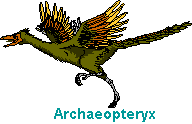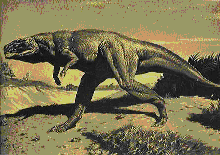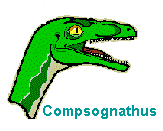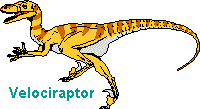Archaeopteryx. One can trace the origins of the debate
to more than 100 hundred years ago, to the discovery of one of the most
famous of all fossils, Archaeopteryx. In 1860, workers in
the Solnhofen limestone quarry in Bavaria had found the imprint of a small
feather. This finding suggested that an animal coated with feathers
must have existed around the Jurassic period. Then, in 1861 a complete
skeleton of Archaeopteryx lithographica was found near Solnhofen. One of the reasons why the specimens of Archaeopteryx are so important
is that while indeed had feathers, it also possessed many non-avian features.
It had small teeth in its jaws, claws on its forelimb digits which were
free to move, and a long vertebral tail, which are all reptilian characteristics
not seen in modern birds. The skeletal characteristics of Archaeopteryx are closer to those of reptiles
- dinosaurs, in particular. Does this mean that Archaeopteryx is
a "missing link" between reptiles and birds? There was quite a debate
(and disbelief) in both scientific circles and the culture at large after
its discovery. Recall that this was only two years after the publication
of Darwin's controversial Origin of Species in 1859.
One of the reasons why the specimens of Archaeopteryx are so important
is that while indeed had feathers, it also possessed many non-avian features.
It had small teeth in its jaws, claws on its forelimb digits which were
free to move, and a long vertebral tail, which are all reptilian characteristics
not seen in modern birds. The skeletal characteristics of Archaeopteryx are closer to those of reptiles
- dinosaurs, in particular. Does this mean that Archaeopteryx is
a "missing link" between reptiles and birds? There was quite a debate
(and disbelief) in both scientific circles and the culture at large after
its discovery. Recall that this was only two years after the publication
of Darwin's controversial Origin of Species in 1859.
The
reign of dinosaurs. In order to understand the differences
in the two hypotheses of bird origins, we must take a brief look at the
evolution of dinosaurs. The Mesozoic era (next 150 million years) is
often called "the Age of Reptiles." During this era, dinosaurs, as
well as other reptiles, took over the role of Paleozoic amphibians as the
dominant terrestrial vertebrates. Mammals already existed in the
Upper Triassic, but they were small and powerless in the presence of huge
dinosaurs.
 What are dinosaurs? Based
on skeletal features, dinosaurs are characterized by their upright posture
of the rear limbs. Many of the early dinosaurs were probably bipedal
and walked parasagittally. But, these feature are not all that differentiate
other Mesozoic reptiles from dinosaurs. For a long period of time,
it was assumed that dinosaurs had a low metabolic rate and relatively small
brains, and that they were slow and clumsy animals. This view has
been changed drastically during the last 20 years. Some evidence
suggests that dinosaurs were much more active animals than previously considered.
Some dinosaurs may have had a high metabolic rate and large brain size,
comparable to birds and mammals. Some of them might have even been
warm-blooded. This changing view has been reflected in movies and
books about dinosaurs: old films often show rather slow, lumbering, and
dumb dinosaurs while new films (e.g., Jurassic
Park, The
Lost World) present fast-moving, agile, and cunning animals.
However, the notion of warm-blooded dinosaurs is not without its critics.
The temperature during this period was much different than that of today.
Due in part to prevelant volcanic activity, warmer and tropical climates
existed over much of the earth. Therefore, even cold-blooded reptiles may
have been more active that their modern counterparts, deriving the necessary
operating body warmth from the ambient temeprature.
What are dinosaurs? Based
on skeletal features, dinosaurs are characterized by their upright posture
of the rear limbs. Many of the early dinosaurs were probably bipedal
and walked parasagittally. But, these feature are not all that differentiate
other Mesozoic reptiles from dinosaurs. For a long period of time,
it was assumed that dinosaurs had a low metabolic rate and relatively small
brains, and that they were slow and clumsy animals. This view has
been changed drastically during the last 20 years. Some evidence
suggests that dinosaurs were much more active animals than previously considered.
Some dinosaurs may have had a high metabolic rate and large brain size,
comparable to birds and mammals. Some of them might have even been
warm-blooded. This changing view has been reflected in movies and
books about dinosaurs: old films often show rather slow, lumbering, and
dumb dinosaurs while new films (e.g., Jurassic
Park, The
Lost World) present fast-moving, agile, and cunning animals.
However, the notion of warm-blooded dinosaurs is not without its critics.
The temperature during this period was much different than that of today.
Due in part to prevelant volcanic activity, warmer and tropical climates
existed over much of the earth. Therefore, even cold-blooded reptiles may
have been more active that their modern counterparts, deriving the necessary
operating body warmth from the ambient temeprature.
Where did dinosaurs come from? Dinosaurs
belong to the superorder Archosauria, an assemblage of different forms,
which originally diverged from the ancestral diapsids by the late Paleozoic.
The first dinosaurs appeared by the Middle Triassic in South America.
From the late Triassic to the end of the Cretaceous, dinosaurs showed extensive
radiation into a variety of groups and ruled the land, sea, and aerial
environments. Dinosaurs can be divided into two large groups based
on the structure of the pelvis: the saurischians and the ornithischians.
The saurischian dinosaurs split further into two distinct lineages, the
herbivorous sauropods (e.g., Brachiosaurus) and the carnivorous theropods
(e.g., Tyrannosaurus), which appeared in the late Jurassic. All ornithischians
were herbivores (e.g., Stegosaurus).
Where did dinosaurs go? All
dinosaurs disappeared suddenly (by geological time standards) by the end
of the Cretaceous (65 million years ago). The exact cause of the
extinction has been debated rigorously and extensively. At the end
of the Mesozoic, did a catastrophic event (e.g., the impact of a large
meteorite or asteroid) occur and kill plants and animals, as in the Alvarez
hypothesis (Alvarez, 1987)? Or, were
dinosaurs vulnerable to gradual geological changes (e.g., lowering of the
temperature) occurring on the earth at this time? Whatever the probable
cause, whereas dinosaurs (as well as numerous other plant and animal species)
disappeared, the ancestors of mammals and birds survived.
The Theropod
Dinosaur Hypothesis
(Origin
of Birds: Approx. 150 MYA)
Early theory. Thomas Huxley, friend and prominent
defender of Charles Darwin and his then radical theory of evolution, was
an early proponent of the dinosaur origin of birds. He was impressed
by the many structural similarities in the bones of Archaeopteryx and Compsognathus,
a theropod from the Solnhofen Limestone. In fact, for several decades a specimen of Archaeopteryx was misidentified
as a juvenile Compsognathus (Chatterjee, 1997). Huxley also noted
35 features shared between the hindlimbs of the giant theropod Megalosaurus
and modern ostriches, which did not occur together in any other animal
(Padian & Chiappe, 1998). He was particularly impressed by the
similarities in the mesotarsal ankle structure indicative of a bipedal
gait, which is somewhat rare in the overall scheme of vertebrate locomotion.
In fact, for several decades a specimen of Archaeopteryx was misidentified
as a juvenile Compsognathus (Chatterjee, 1997). Huxley also noted
35 features shared between the hindlimbs of the giant theropod Megalosaurus
and modern ostriches, which did not occur together in any other animal
(Padian & Chiappe, 1998). He was particularly impressed by the
similarities in the mesotarsal ankle structure indicative of a bipedal
gait, which is somewhat rare in the overall scheme of vertebrate locomotion.
However, the theropod dinosaur origin
of birds was largely discarded with the publication of the influential
The Origin of Birds by Gerhard Heilmann in 1916, and its English
translation in 1926. Even
though Heilmann showed that birds were more anatomically similar to theropod
dinosaurs than any other fossil group, he concluded that birds and dinosaurs
must have originated from a more ancient reptilian group. His conclusion
relied on the widely accepted concept of the time that evolution is irreversible.
It was thought that once a feature was lost in evolution it could not be
regained. The small theropod fossils known at that time (e.g., the
coelurosaurs) lacked clavicles, which are thought to have become fused
to form the wishbone in birds. Since reptiles have clavicles, this
would have meant that theropods lost their clavicles, and then clavicles
reappeared in the reptiles leading to birds. To Heilmann, this was
too large a discrepancy to support a theropod origin of birds. Heilmann
argued that both birds and dinosaurs must have originated from some common
ancient reptilian group that had clavicles, probably the pseudosuchian
thecodonts. This line of thecodonts then led to the two great divergent
lineages of dinosaurs and birds (Padian & Chiappe, 1998). Heilmann's
arguments held sway for about the next 50 years in evolutionary biology.
The theropod
revival. Heilmann's fatal argument regarding
the loss of clavicles was overcome by the discovery of other fossils.
In 1936, Charles Camp discovered the fossil remains of an early Jurassic
theropod which possessed clavicles, and since that time other theropods
with clavicles have been found (Padian & Chiappe, 1998). Huxley's
theropod dinosaur origin hypothesis was resurrected primarily by John
Ostrom in the late 1960's. Ostrom studied Dromaeosaurs, a small
theropod form which included the sickle-clawed predatory dinosaurs  Deinonychus
and Velociraptor
(the inspiration for one of the villains of Steven Spielberg's Jurassic
Park). There are several distinctive characteristics that Ostrom
argues links birds and the dromaeosaurs. The Dromaeosaurs had a unique
semilunate (moon-shaped) carpal wrist morphology, a long coracoid, three-fingered
arms and three-toed feet, and a stiff tail (Chatterjee, 1997). Studies
from Jacques Gauthier employing cladistic analysis confirmed Ostrom's
assertion that birds evolved from small theropod dinosaurs (Padian &
Chiappe, 1998). Gauthier's studies, and ones conducted more recently,
demonstrate that before the existence of birds many preavian theropods
had features traditionally considered exclusively "bird-like." These
bird-like characters include: a bipedal stance, hollow bones, elongated
forelimbs with three-fingered hands, elongated metatarsals (foot bones)
with three-toed feet, a wishbone, and a backward-pointing pelvis (Padian
& Chiappe, 1998).
Deinonychus
and Velociraptor
(the inspiration for one of the villains of Steven Spielberg's Jurassic
Park). There are several distinctive characteristics that Ostrom
argues links birds and the dromaeosaurs. The Dromaeosaurs had a unique
semilunate (moon-shaped) carpal wrist morphology, a long coracoid, three-fingered
arms and three-toed feet, and a stiff tail (Chatterjee, 1997). Studies
from Jacques Gauthier employing cladistic analysis confirmed Ostrom's
assertion that birds evolved from small theropod dinosaurs (Padian &
Chiappe, 1998). Gauthier's studies, and ones conducted more recently,
demonstrate that before the existence of birds many preavian theropods
had features traditionally considered exclusively "bird-like." These
bird-like characters include: a bipedal stance, hollow bones, elongated
forelimbs with three-fingered hands, elongated metatarsals (foot bones)
with three-toed feet, a wishbone, and a backward-pointing pelvis (Padian
& Chiappe, 1998).
Feathered
dinosaurs? Feathers are an unmistakable trait
of birds, and the relative lack of fossils showing the origin and evolution
of feathers has driven much of the debate over bird origins.
A turkey-sized dinosaur named Sinosauropteryx and another find dubbed Protarchaeopteryx, were described by Ji Qiang and Ji Shu'an of the
National Geological Museum of China in two reports (Padian & Chiappe,
1998). These fossils were found in Liaoning province in strata dating
to the late Jurassic or early Cretaceous. Sinosauropteryx has fringed
elements along its backbone and body surface which may be feather precursors.
It does, however, have many differences with birds and probably is related
to the theropod Compsognathus. This finding may be either a maniraptoran
theropod or possibly a bird, but a full description of its anatomy still
awaits publication (Padian & Chiappe, 1998). Hou and colleagues
(1995) have reported the finding of Confuciusornis sanctus, a pigeon-sized
specimen from a formation in northeastern China dated to the Jurassic-Cretaceous
boundary. This species may have lived before Archaeopteryx, but exhibits
the hindlimbs and retroverted pubis similar to Archaeopteryx. The
skeleton also has unfused carpal elements and long fingers with long, curved
claws (Hou et al, 1995). There also exist avian-like contour feathers,
which could indicate endothermic physiology (Chatterjee, 1997).
The Basal
Archosaur Hypothesis
(Origin
of Birds: Approx. 230 MYA)
There are several other lines of criticism
leveled at the theropod dinosaur hypothesis. First, scientists
disputing the theropod dinosaur origin of birds note that the appearance
of "bird-like" theropods in the fossil record (at least those found to
this point) occurs about 75 million years after the origin of birds
as indicated by Archaeopteryx specimens (Feduccia, 1996). In
addition, the arguments for a more ancient ancestry of birds, from the
basal archosaurs and not their theropod dinosaur descendants, can be summarized
by considering the debate over "hot-blooded" dinosaurs, feather development,
and the origins of flight.
Hot-blooded
dinosaurs? In living vertebrates, only birds and
mammals are warm-blooded or endothermic ("heat from within").
These organisms have high metabolic rates (5-10x that of reptiles) and
can maintain a more constant body temperature. Heat in birds and
mammals is aerobically produced from the breakdown of glucose in the presence
of oxygen. Most reptiles, fish, and amphibians are cold-blooded or ectothermic ("heat from outside"), meaning their body heat is primarily
derived from the environment. Ectothermic organisms like reptiles
are constrained by their reliance on environmental warmth and their metabolic
system. They are capable of brief bursts of intense activity, followed
by periods of rest. These inactive periods are necessary due to the
large amounts of lactic acid accumulation which results from their anaerobic-type
metabolism. Because birds with feathers and mammals with hair do
not rely on ambient temperature for warmth as reptiles do, they can operate
in a wider variety of environmental temperatures. This has enabled
them to forage and migrate over large distances, contributing to their
wide ecological dispersion. The trade-off for endothermic organisms,
however, is a relatively constant and large intake of food to maintain
the calories needed for heat generation.
The traditional view of all the dinosaurs
as large, lumbering cold-blooded reptiles has been challenged by several
scientists. Proponents of the "hot-blooded" dinosaur hypothesis
include Robert Bakker and, to a lesser extent, John Ostrom.
Arguments for endothermic dinosaurs include considerations of their bipedal
stance, the microscopic structure of their bones, and theories on brain
size and intelligence in dinosaurs (Feduccia, 1996). While beyond
the scope of this review, there are several other lines of evidence both
for and against the existence of endothermy in dinosaurs, and the reader
is referred to an excellent book by Feduccia (1996). The existence
of hot-blooded dinosaurs has important implications for attempts at reconstructing
the origin and evolution of birds. Endo- versus ecto-thermy is tied
together with the original adaptive value of feathers, whether they evolved
primarily as adaptations of scales to assist in flight, or whether they
originally served as insulation and then secondarily developed the complex
structure which makes them so effective for flight.
Theories
of flight. The excellence of the avian design
for flight, along with the paucity of fossil evidence for transitional
forms, has made the evolution of flight in birds an area of tremendous
speculation. There are two primary theories regarding the origins
of flight, the cursorial ("ground-up") and arboreal ("tree-down")
theories. Cursorial theories in general assume that protobirds
and Archaeopteryx were bipedal and terrestrial, and they evolved feather-like
precursor structures primarily as insulation. Endothermy is
usually assumed to have existed in these avian precursor organisms.
Basically feathered dinosaurs, these forms eventually began to use their
feathered forearms to leap and glide. They may have even used their
feathered wings as insect traps for feeding (Ostrom, 1979). If endothermic,
these forms could be rapid bipedal runners, eventually leaping and hopping
their way into powered flight.
Arboreal theories tend to view the
protobirds as already having invaded the trees to escape ground predation,
to nest, or some other adaptive reason. They would have been able
to climb trees with their foreclaws and then glide to lower perches, from
tree to tree, or to the ground. The claws of Archaeopteryx are argued
to be like those of many modern perching species and inappropriate for
a swift, ground-running organism (Feduccia, 1996). Amongst the trees,
the danger of falling led to strategies to slow descent; for example, increasing
drag by enlarging the body surface area (outstretching the limbs) and the
evolution of ever-longer feathers. These adapted forms would be more
likely to survive an accidental fall from the trees compared to equally
clumsy conspecifics.
If early bird-like forms like Archaeopteryx
may have been ectothermic, arboreal theories suggest feathers were not
crucial for body temperature regulation.
Arboreal theories suggest that the scales which gradually evolved into
feathers did so for the sole purpose to facilitating gliding, lift, and
eventually flight. The structure of Archaeopteryx feathers is similar
to that of modern birds. The flight feathers (on avian wings) and
contour feathers (like those found on the breast) have dissimilar structure.
The primary flight feathers show vane asymmetry, with differing widths
of the vane on either side of the shaft, or rachis. In birds who
have lost the ability to fly, like some species of rail (Atlantisia
rogersi), the feathers have degenerated into superficially hair-like
structures (Feduccia, 1996). Of course, it is possible that some variant
theory encompassing both ground-up and tree-down behaviors drove the unique
structure of skeleton, musculature, and feathers in birds leading to flight.
Since it would be cooler above ground in the trees, there could have been
a tandem development of the flight-supporting and thermoregulatory contributions
of feathers. New fossil findings, more sophisticated models of flight
physics, and comparative anatomical studies of modern forms will undoubtedly
shed new light on the questions of avian evolution and flight. Constructing
the evolution of birds and complex behaviors like powered flight requires
a great deal of speculation and interpretation of sometimes meager data;
in light of this fact the debate over bird origins is sure to continue.
Next Section: Evolution of Retinal
Structures

